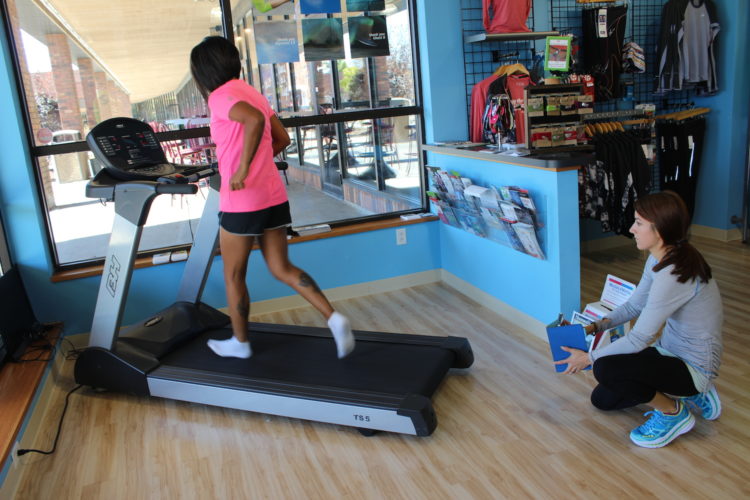As an endurance athlete, I run 50 to 60 miles a week. I know my shoe size. I know what kinds of shoes I like. And I know how my shoes should fit and feel.
Or, at least, I thought I did. Then I volunteered to check out the fitting processes at two local specialty running stores, you know, for the free education they offered and also for the free shoes I would get to review for the magazine. (I cannot tell a lie.)
Like many before me, I thought I was an educated consumer until the experts at New Balance and Big River Running Company assessed my stride and got all scientific on my toesies. Here’s what I found out: 1) I need a size 8.5 shoe, not a size 9. 2) I do not have a wide foot, contrary to what I believed. 3) I’m better off running in a neutral shoe with 4mm to 6mm heel-to-toe drop rather than going minimal or maximal when buying a new pair of shoes.
“And your right foot is about a half inch longer than your left foot,” added Caitlin Howe, store manager at Big River’s West County location.
What!?!
A Guessing Game
All the education you can give yourself at home or online will only take you so far in getting to know your feet and what shoes you need. It’s an educated guess, and your guess is as good as mine.
“We don’t just put people in pretty shoes. We fit each individual in specific shoes based on their activity and needs, so they can fully optimize the technology our shoes have to offer,” said Beth Eilers, sales manager at New Balance Creve Ceour.
The shoe-fit process at New Balance started with a discussion of what type of running I did: the terrain I ran on, how many miles I ran each week, what type of shoes I was currently running in, and what I liked and disliked about them. Pretty straightforward.
After a stint on a traditional Brannock Device to measure the length, width and arch of my foot, I was moved onto an iSTEP machine. It looks like a floor scale but is actually a state-of-the-art scanning system that identifies arch type and pressure points to capture length and width of the foot to the nearest 10th of a millimeter. Talk about taking the guesswork out of measuring your feet! This data allows the fit expert to recommend orthotics if required.
It turns out I slightly pronate on my right foot, but not enough that I need stability or motion control shoes. While a shoe may correct for pronation or supination, if it hurts, it’s no good, said Eilers. “The trick is to find what stability category you’re in, and once you know that, then you look at shoes from different brands in your category and find one that’s most comfortable on your feet and most comfortable when you’re running in them,” she said.
Based on her findings, Eilers fitted me with the New Balance Leadville 1210v2 (read my shoe review on terrain-mag.com). I opted for to go for a D-width, which is wide. New Balance is known for its custom shoe widths, which few brands currently offer.
Second Opinion
At Big River, I went through a similar Q&A process that covered not only the type of running I did but also any running-related injuries I’ve had, along with my upcoming races and goals.
After measuring my foot — there’s that butterfly-shaped Brannock again — I was given a comprehensive gait analysis as I ran on a treadmill. Along with visual cues, Big River uses the Technique Running App, which records running motion on a tablet or mobile device. The app captured frame-by-frame footfalls that could be reviewed in slow motion to catch any issues that might have been missed during the initial treadmill test.
Based on her findings, Howe confirmed my slight pronation but did not recommend orthotics or inserts. “A well fitted shoe doesn’t only make for a smooth walk, jog or running, it can also aid in correcting biomechanical problem,” said Howe, who advised I get fitted for a shoe every couple of years, or whenever coming off an injury.
“The quality of materials and design of a running shoe is important, but if you continue to wear the wrong fit, it can result in injury and other overuse issues that can further stall not only your recovery but running performance,” Howe said.
In other words, don’t guess yourself into sitting on the sidelines. In a high-impact activity like running, the right shoe can make all the more difference in your performance, whether you’re a novice or a competitive runner.
Author: Shalini Kovach is a competitive ultra runner and lead organizer of Terrain Trail Runners


Leave A Comment